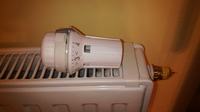Hello, I'm new to this forum, sorry if I added the topic in the wrong place.
I have blockades for radiators in my apartment in position 2, which is around 16 degrees. My apartment is in the middle of the building and it is well insulated, all the radiators are in position 2 and they are cold. One in the large room is also in position 2, but still heats up a lot, I checked the temperature in the room and it is as much as 25 degrees, which is much too much for me and I'm afraid that I will pay a lot for heating, another identical radiator in the same room it is also cold. I have no idea how to set the heater to stop heating. The photo shows a Danfoss radiator head, after downloading, you can see a yellow ring with numbers from 1 to 7 and the letter N.
Thank you very much for help since all the others are cold
since all the others are cold
I have blockades for radiators in my apartment in position 2, which is around 16 degrees. My apartment is in the middle of the building and it is well insulated, all the radiators are in position 2 and they are cold. One in the large room is also in position 2, but still heats up a lot, I checked the temperature in the room and it is as much as 25 degrees, which is much too much for me and I'm afraid that I will pay a lot for heating, another identical radiator in the same room it is also cold. I have no idea how to set the heater to stop heating. The photo shows a Danfoss radiator head, after downloading, you can see a yellow ring with numbers from 1 to 7 and the letter N.
Thank you very much for help
 since all the others are cold
since all the others are cold


